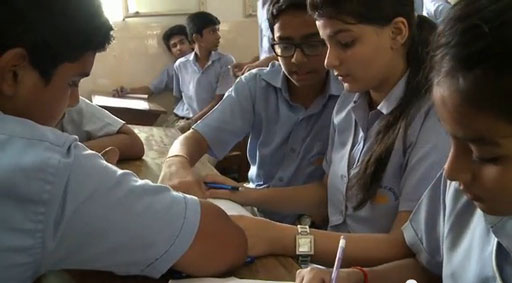2 Drawing a mind map
The best use of mind maps is as a revision tool for making sense of a body of information. So the best time to get your students to draw a mind map (Figure 1) is when you have completed a topic. They will have forgotten some of the things that you covered at the beginning, so in the next activity, you will start with a brainstorm in order to help them remember some of the information.

Activity 2: Helping your students draw a mind map
Before the lesson you will need to decide on the topic that you will be covering. Write out the criteria that you will use to judge the mind maps on a large piece of paper, which you will be able to stick on the wall (Resource 3).
- Gather your students round the front of the class, so they can all see the blackboard. Get them to volunteer anything that they remember about the topic you have just completed. As they offer ideas, write them on the blackboard. Write the ideas as your students suggest them and don’t attempt to group the ideas at this stage.
- When they run out of suggestions and the blackboard is full, explain that you want them to do a mind map to summarise the topic. Check that they understand what you mean and remind them of the main features of a mind map. Students should work in pairs to produce a mind map. Draw their attention to the criteria for a good mind map on the wall.
- When they have finished, either collect them in for you to mark, or conduct a peer review exercise.
Peer review is helpful for students as it helps them to understand the assessment process. Once they understand the criteria against which they are being judged, they will be able to take more responsibility for their own learning. However, they will need help in the form of clear criteria for the task and clear instructions about how to give feedback to each other. See Resource 4 for more information on monitoring and giving feedback.
Case Study 2: Peer reviews
Mrs Rakhi teaches her students about peer review, using mind maps that they have made.
In the last lesson, my class had worked in pairs to produce a mind map. I explained that today they were going to assess each other’s work. Before we started, we had a discussion about how to give feedback. I explained that it was important to highlight the good points. If something could be improved, I encouraged them to think of ways of making the criticism constructive to help each student move forward with their learning. Here are some of the examples I used:
- ‘It looks very muddled’: I can see the main structure, but perhaps you could have used different colours to make the detail clearer.
- ‘There is nothing on preparing salts’: You have covered a lot of detail. It would be even better if you had included something on the methods of preparing salts.
- ‘Some of the science is wrong’: It is very well presented, but you should check some of the details.
- ‘It is not detailed enough’: The structure is very helpful. It would be good to have a bit more detail at the end of the branches.
For the peer review, I asked each pair to join up with another pair and swap mind maps. I wrote the criteria for assessing the mind maps on the blackboard so that everyone could see it clearly.
Each pair assessed the mind map they had against the criteria. I said, ‘Write down two things that you really like about the mind map and suggest one thing that could be improved.’ Then they swapped back again and I gave them a few minutes to make some changes to their mind maps.
Finally, I asked each pair to put their mind map on the desk and I let them walk around the room and look at each other’s. I did this because I think that the best way to get better at drawing mind maps is to see lots of examples and to think about what makes some better than others. We had a vote on which was the best one, and I asked three different people to explain why they had voted for that one.
Pause for thought
|
Research (Hattie, 2012) shows that one of the things which has the most impact on students’ learning is getting feedback on their work. Obviously they get feedback from you, but by making use of peer review and self-assessment, your students will get more feedback and will get a better understanding of the assessment process. However, if they have not assessed work before, they will need help. They need clear assessment criteria and guidance about how to give feedback. Starting with work that has been produced in a group is less threatening that looking at the work of individuals. Also, you need to think carefully about who is giving feedback and make sure that students have the opportunity to work with different people. It is important that they trust and respect the person giving the feedback.
1 Introducing mind maps
